I hadn’t quite realized until my recent trip to China just how little I know about Chinese food. Most of the Chinese food I grew up with was Cantonese, which I have to say is not too shabby of a cuisine to be born into. But it also led me to believe that a meal is not complete without rice, that Chinese people don’t eat raw vegetables, and — even more appalling — that Chinese people don’t eat cheese.
I was surprised, fascinated, and completely delighted to have many of these stereotypes disproved during this trip, and I didn’t even have to leave Beijing in the process. The city lives up to its status as capital by representing the diverse cuisine of different areas throughout the country. Each region in China actually has its own provincial office government restaurant in Beijing, and I’m told you can usually count on an authentic meal at these. I didn’t have to resort to eating at the “official” places, though, as there are plenty of interesting restaurants around the city serving up regional foods. Alas, I did not get a chance to try yak cheese, and that is probably one of my greatest regrets. Next time, definitely!
Yunnanese. One of the most unique regional cuisines I was introduced to on this trip was Yunnanese. Probably it’s because of my Vietnamese background, but I love the Southeast Asian influences in these dishes (Yunnan is in southwest China, bordering Myanmar, Laos, and Vietnam), with a bit of sourness and the use of fresh herbs and greens. It hardly even tasted Chinese to me. With an emphasis on vegetables, Yunnanese food is becoming really popular in China, especially with the foreigners. I hope this catches on in the US sometime soon!
We went to two Yunnanese restaurants in Beijing. The first is the ever-popular Dali, a courtyard restaurant near Nanluguoxiang, a street of renovated hutong shops and restaurants. We came here for dinner on my 30th birthday, and the ambience is just perfect for that. The restaurant is in a restored siheyuan, a traditional courtyard home, so it’s small and intimate, with the typical four structures surrounding an open courtyard in the middle, with seating both inside and out. Dali has a set menu for 100RMB, so there’s no need to order. Unfortunately, the service left a bit to be desired, and one of the drawbacks to that was we never quite knew what we were eating, especially since there’s no menu. The food was decent, but nothing particularly stood out.
 Clockwise, bottom four photos: 1. tofu skin with mint and tomatoes in a vinaigrette; 2. mushrooms stir-fried with garlic and chili, and in the background is a frisee salad that had a very sour dressing, even for my taste; 3. our least favorite dish: fish baked over lemongrass — a bit bland overall, and we couldn’t taste much lemongrass but definitely tasted the paprika sprinkled on top; 4. crispy fried pieces of chicken with kaffir lime leaves, chili, and I believe pandan;Â not pictured is a stir-fried shrimp dish with kaffir lime leaves.
Clockwise, bottom four photos: 1. tofu skin with mint and tomatoes in a vinaigrette; 2. mushrooms stir-fried with garlic and chili, and in the background is a frisee salad that had a very sour dressing, even for my taste; 3. our least favorite dish: fish baked over lemongrass — a bit bland overall, and we couldn’t taste much lemongrass but definitely tasted the paprika sprinkled on top; 4. crispy fried pieces of chicken with kaffir lime leaves, chili, and I believe pandan;Â not pictured is a stir-fried shrimp dish with kaffir lime leaves.
The second Yunnanese restaurant, The Middle 8th, we actually went to for my husband’s last meal in China (he left just a couple days before me), and I was grateful it turned out to be a memorable one. We came here after various friends we met in China each raved about it, and it was easy to see why. The restaurant has clean, modern decor; the staff was nice; and the food was just amazing. The prices are higher by Chinese standards, but reasonable by North American standards. The menu is extensive, with lots of beautifully photographed photos of fascinating ingredients — herbs and mushrooms and vegetables I’d never heard of before. We really loved everything we ordered: (food shots, clockwise below) 1. gorgeous edible wild mushroom soup that comes in individual cups; 2. baked veal and cubes of abalone mushroom in black pepper sauce — one of the highlights, along with the soup; 3. stir-fried wild termitomyces (type of mushroom) with Yunnanese ham; 4. braised ostrich cartilage, lemongrass, and celery in “special sauce”; 5. mixed Yunnanese edible potherb salad.
 Dali 大里
Dali 大里
东城区鼓楼东大街å°ç»åŽ‚胡åŒ67å·
Dongcheng District, Gulou East Avenue (Gu Lou Dong Da Jie), Xiao Jing Chang Hu Tong
Phone: 8404-1430
The Middle 8th ä¸å…«æ¥¼ (several locations)
æœé˜³åŒºå…‰åŒ–è·¯9å·ï¼Œä¸–贸天阶å—楼L404A
L404A, South Tower, The Place, 9 Guanghua Lu, Chaoyang District
Phone: 6587-1431
Shaanxi. We ate Shaanxi food at Qin Tang Fu, a restaurant styled in the traditional setting of the Shaanxi people, with folk art on the walls, local fabric prints on the chair cushions, and chairs and tables that were low to the ground. We had Shaanxi-style garlic and vinegar noodles (yiu po che mian), which are wide and chewy. We also had their famous ro jia mo — sort of like a Chinese pulled pork sandwich, with slow-cooked, spiced pork served on an unleavened bun. And we also got the suantang shuijiao, (lamb) dumplings in a sour and spicy soup. Sour is my flavor of choice, and I was excited to find it in quite a few types of cuisines in China.
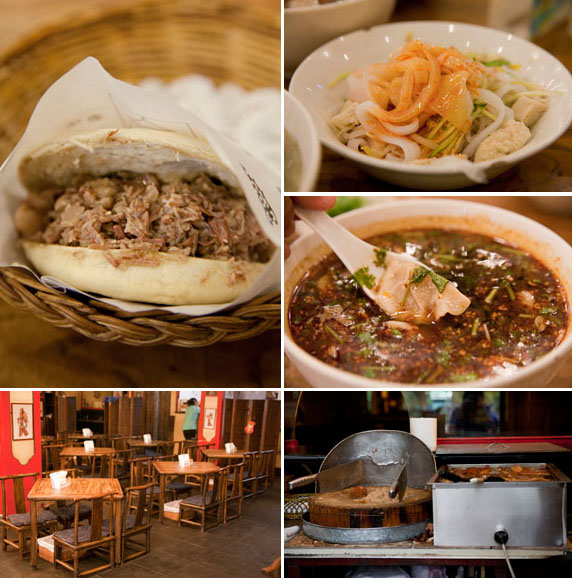 Qin Tang Fu 秦å”府
Qin Tang Fu 秦å”府
69 Chaoyangmen Nan Xiaojie, Chaoyang district
秦å”府,æœé˜³é—¨å—å°è¡—69å·
Phone: 6559 8135
Open in evenings.
Uighur. Crescent Moon was another frequently mentioned favorite among friends in China. It serves Uighur food from the northwestern province of Xinjiang. A lot of the dishes included lamb and tasted quite similar to the Tibetan food we tried on this trip. The lamb dishes were good, but the flatbread we ordered was rather bland and dense. The spicy beans you see below are actually Sichuanese but show up on a lot of menus. My favorite from this meal was the homemade yogurt — delicious! I may not have gotten cheese this trip, but I think dairy ought to count as not-your-average-Chinese-food.
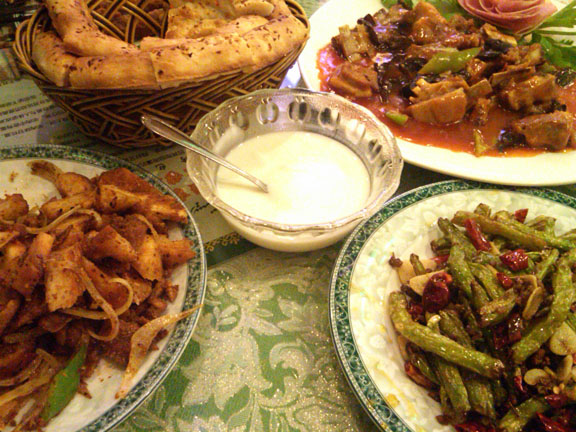 Crescent Moon 弯弯月亮
Crescent Moon 弯弯月亮
东城区东四å…æ¡16å·ï¼ˆä¸œå››åŒ—大街附近)
16 Dongsiliutiao (just off Dongsi Bei Dajie), Dongcheng district
Phone: 6400-5281
Hakka. Kejia Cai was a bit more familiar to me as far as Chinese food goes. The most famous Kejia (also known as Hakka) dish is probably salt-baked chicken, which I don’t often get to eat made the traditional way — baked whole in a casing of salt — but you may remember I like to make quite frequently in a fast and easy version. I’m not sure if the chicken I ordered here was really baked in salt, but it was plenty good and came with a wonderful sesame dipping sauce. We also ordered some yanju xia or salt-baked shrimp on skewers, which was very fragrant and nice and crispy. We got a fish dish as well, but they mixed up our order, so instead of the fish baked in foil (which got great reviews), we ended up with a fried fish that we weren’t so crazy about. I’d also taken to ordering crown daisy or chrysanthemum greens with many of my meals in China. I normally eat this type of vegetable cooked and often in hot pot, but in China it’s also commonly served as a salad tossed in vinaigrette. It’s found on quite a few menus, which makes getting your serving of veggies a bit more convenient. I actually think I prefer crown daisy raw now, especially if it’s the more tender and young shoots, as you can taste more of the aroma of the leaves. They are a little bit like arugula.
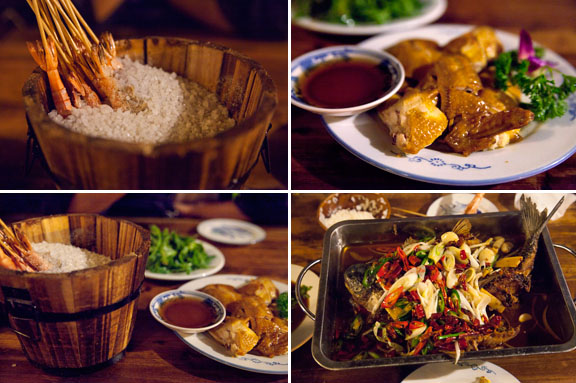 Kejia Cai 客家èœ
Kejia Cai 客家èœ
Southeast bank of Qian Hai
– Could not find the correct Chinese address for this, but this restaurant is actually right off the main lake in the Houhai backpacker’s district, on the right side of the lake, a little north of Bei Hai Park’s north entrance.
Phone: 6404-2259
Guizhou. Guizhou food is influenced by the Miao minority group (a subgroup of the Hmong people), and this meal at Jun Qin Hua is the one I talk about when people ask me to name my one favorite meal from our time in China. Just look at that pot of sour and spicy fish soup! First of all, the fish is fresh — as in, was still swimming when we walked in the door. Second, that soup is heated and used to cook your fish right at the table. Third and most exciting, take a look at the dipping sauce that goes with it! It’s a blend of chopped scallions, minced fresh garlic, crushed peanuts, and a block of fermented beancurd. This was very reminiscent of the dipping sauce my family makes when we have lamb hotpot. The waiter monitored the cooking for us, and when the soup was boiling, he scooped a ladleful into our dipping bowls and told us to stir it all together to create the sauce. We also got lazi ji, which is made of pieces of chicken covered in whole garlic and chili. I really wasn’t a fan of this dish. The predominant ingredient was, if I remember correctly, something with a texture between cooked daikon and gelatin. Thankfully, the zaola tudou pian more than made up for it. Just imagine thick-cut potato chips fried with scallions and Guizhou crushed chilis known as zaola. I ate every last bit.
 Jun Qin Hua å›ç´èŠ±
Jun Qin Hua å›ç´èŠ±
东城区,美术馆åŽè¡—88å·
88 Meishuguan Houjie, Dongcheng district
Phone: 6404-7600
So, this is my last post on my food adventures in Asia last summer/fall. To commemorate that, I have to share with you these vintage postcards we found at a shop called Aruyo in Nanluguoxiang. They are made by a company called Kitsch China, which has a shop in Shanghai. We almost completely bought out some of the cards that Aruyo had in stock, including a bunch of cute panda ones. :) I gave a few to my sister and decided to frame a couple for our apartment. These correspond with the three cities my husband and I visited this trip and the foods we tried in those places — la mian (hand-pulled noodles) in Beijing, huo guo (hot pot) in Chengdu, and shengjian (fried soup dumplings) in Shanghai.

Resources. Finally, these are the sites that helped me figure out what to eat in the capital…
Savour Asia – Very extensive Beijing eating guide, as well as a great suggested itinerary for sightseeing.
The Beijinger – Excellent local magazine on things to see, do, and eat. Especially helpful are the Google maps included with each restaurant listing and review.
Time Out Beijing
Appetite for China
The Guardian’s Top 10 Places to Eat in Beijing
National Geographic’s Beijing Restaurants
World Foodie Guide
 Durians at Chow Rasta Market in George Town, Penang, Malaysia.
Durians at Chow Rasta Market in George Town, Penang, Malaysia. Sadly, when I have a craving for durian these days, I end up getting a durian sinh to (smoothie) at the Eden Center out in Falls Church, VA, or getting a whole one (previously frozen, unfortunately) at Grand Mart. It will just have to tide me over until my next trip to Southeast Asia…
Sadly, when I have a craving for durian these days, I end up getting a durian sinh to (smoothie) at the Eden Center out in Falls Church, VA, or getting a whole one (previously frozen, unfortunately) at Grand Mart. It will just have to tide me over until my next trip to Southeast Asia…


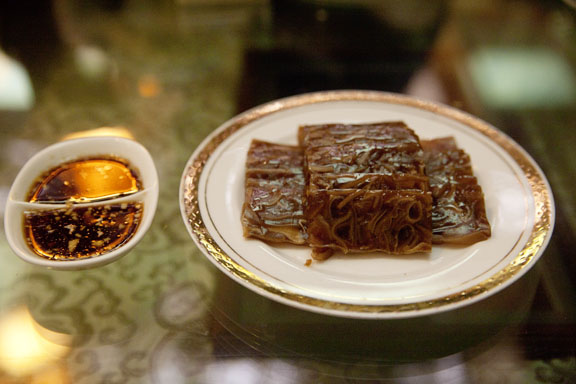
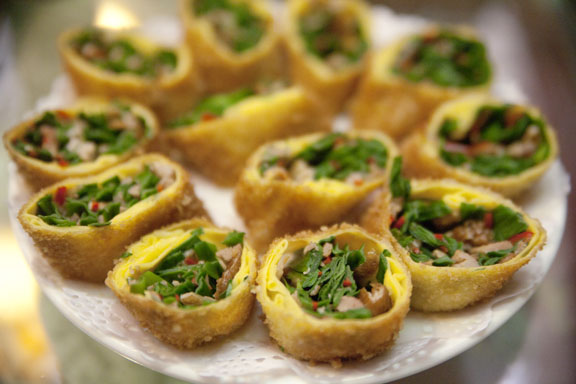
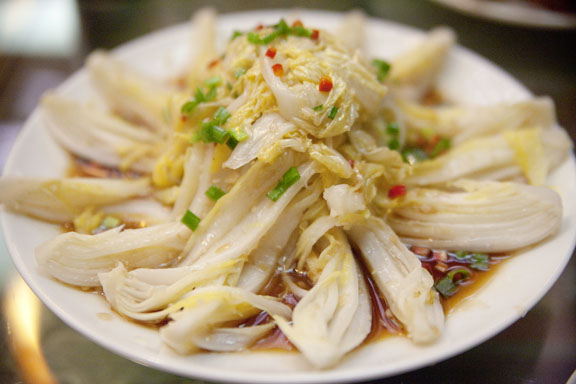




















Connect with us